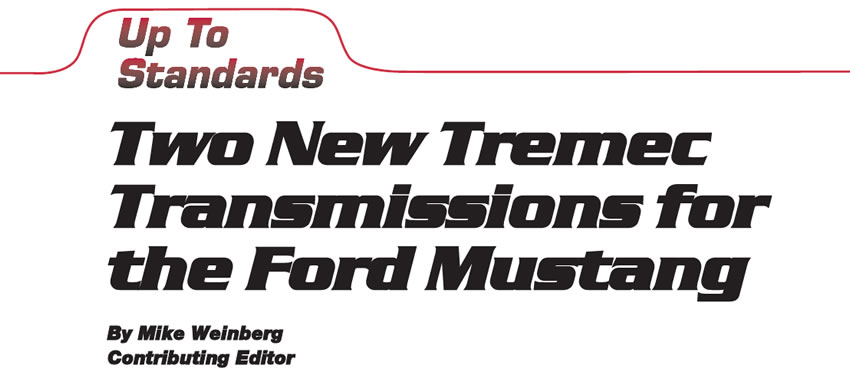Two New Tremec Transmissions for the Ford Mustang
The TR3650 is manufactured by Tremec Corp., a state-of-the-art transmission manufacturer with facilities in the United States and Mexico. Tremec bought the standard-transmission line from BorgWarner Corp. and continues to manufacture the T5, T45, TR3550, TKO and T56 transmissions.

Ford’s New M5R4: A Radical Design Change in Rear-Wheel-Drive Manual-Transmission Technology
In 2002 Ford introduced a new four-door model of the venerable Explorer and its sister, the Mercury Mountaineer. The manual-transmission option for the new four-door model is a five-speed fully synchronized unit designated the M5R4 or M5OD-R4. The M5R1 transmission we all know and love has been replaced by a radical new design built by Mazda. This unit bears no resemblance to the M5R1.

Handling 6-Speed Heavyweights
The present trend toward larger and heavier-duty pickups has now brought the ZF S6-650 6-speed manual gearbox onto the scene. This 6-speed transmission was introduced in 1999 in the Ford F 250, F 350, F 450, F 550 and stripped-chassis models. It has been used behind diesel engines from 1999 to current production and behind gasoline engines starting in 2002 models. GM adopted the S6-650 transmission for use in its 2500 and 3500 heavy-duty pickups behind both gas and diesel engines in the 2001 model year.

The State of the Union on Standard Transmissions
In days gone by, cars were built with manually shifted transmissions as standard equipment, and automatic transmissions were an extra-cost option. This gave rise to the term “standard” as a reference to the stick-shift transmission. Along the way, automatics have steadily gained market share and now make up about 80% of the market in the United States. In Europe the opposite is true. Automatics are slowly gaining popularity, but just a fraction of the cars on the road are self-shifting.

Understanding Gear Technology
The transmission-repair industry is all about gears. The word transmission means transmitting or sending, and that is exactly what an automotive transmission does. The transmission sends the power produced as torque (turning force) by the engine and transmits it in a usable form to the driving wheels.

Getting a Handle on Half a Dozen Speeds
In the 1993 model year GM introduced the T56 six-speed transmission in the F body cars (Camaro/Firebird). The transmission was designed and manufactured by BorgWarner Automotive and was an evolution of the earlier T5 design. Larger and capable of handling more torque and horsepower, this trans became an instant hit with performance enthusiasts, race teams and hot rodders.

Solving Some Tough Diagnostic Problems On The New Process 2500, New Venture 535 Transmission
The New Process 2500 transmission, also known as the New Venture 535 transmission. is an aluminum-cased 5-speed, rear-wheel-drive unit introduced by Chrysler in 1987 and produced through 1992. The unit has a top-mounted shifter and a 4-bolt aluminum top cover and was spec’d to use 10W30 motor oil as a lubricant fill. This unit was found in B/AB Ram Van/Ram Wagon, D/AD Ram pickup/Ramcharger/Ram Cab & Chassis, and N/AN Dakota, Dakota Sport/Dakota Convertible. This design has created some noise and shift problems that have been difficult to solve. This article addresses these complaints and what will fix them.

Making Money in the Clutch
If you are in the transmission-repair business, you will work on a percentage of stick transmissions. This will inevitably lead to replacing worn-out or damaged clutches, since a large percentage of transmission damage starts with a worn or improperly adjusted clutch. There is good money to be made in clutch repair, and any time you remove a stick transmission, make sure you remove and inspect the clutch.

Tips and Techniques for Standard-Transmission Diagnosis, Part 2
When you arrive at a formula that fits your operation, it must become what the Army used to call SOP (standard operating procedure) for handling technical problems, comebacks, never-lefts, initial diagnosis and root-cause failure analysis. Throw away the shotgun approach, stop making assumptions and follow the methodical process that you design to lead you to consistent problem solving. Let’s look at some real-world scenarios.

Tips and Techniques for Standard-Transmission Diagnosis, Part 1
Our profession is concerned almost exclusively with problem solving. It is important that we learn to diagnose and correct the problems that our customers bring us in a proficient manner, because time is money. Once you have agreed with your customer on a price for your labor, any extra time spent on the repair costs you twice over. The reason for this is that you cannot charge for any further time spent on the project, and you could put that same time to use on a paying job. This should be common sense, but every technician will attack a problem or comeback in a different manner.

